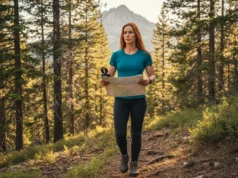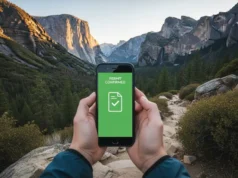In this article
Imagine standing at a trail junction with a 1:24,000 USGS topographic map in hand—those brown contour lines, blue rivers, and black trails that turn a flat sheet into a three-dimensional model of the wilderness. This guide is your step-by-step key to transforming every contour line, map legend, and map scale into confident terrain visualization and safe, enjoyable routes.
Why Topo Maps Are a Hiker’s Most Essential Tool
A USGS topographic map does far more than trace the trail beneath your boots; it reveals the entire world around the path—displaying the steepness of slopes through close versus wide contour lines, the location of cliffs where lines merge, the shape of U-shaped valleys or V-shaped gullies, and potential escape routes that simple National Geographic Trails Illustrated maps or small-screen Gaia GPS units cannot convey. While a GPS unit pinpoints your location, it offers only a dot on a screen, whereas the contour interval and index contour lines on a topo sheet translate the three-dimensional shape of the land onto a two-dimensional surface, allowing for true terrain visualization. Unlike electronics, a paper USGS map never runs out of batteries, loses signal when clouds gather, or shatters when it slips from numb fingers on a windy ridge; it is the ultimate fail-safe that belongs part of your Ten Essentials system.
Anatomy of a Topographic Map: How Do You Decode Its Language?
Where do you find the map’s “instructions”?
Every 1:24,000 USGS 7.5-minute quadrangle carries its instruction manual in the margins. The map name—formally the quadrangle—appears in bold along the upper margin, flanked by the publication or revision date that tells you how fresh the data is. Adjacent quadrangles are named in smaller type along the borders, creating a breadcrumb trail that lets you leapfrog seamlessly from one sheet to the next when your route crosses map boundaries. The map legend or key in the lower margin functions as the map’s dictionary, explaining symbols for trails, roads, water tanks, buildings, caves, waterfalls, and glaciers so that a dashed line does not masquerade as a road when it is actually a power line.
What does the map scale (e.g., 1:24,000) actually mean?
The representative fraction printed in the margin—most commonly 1:24,000—is the Rosetta Stone that converts inches on paper into feet on the ground. One inch on the map equals 24,000 inches on the earth, which translates to 2,000 feet, a large-scale map that balances generous detail with manageable sheet size. A small-scale 1:100,000 map covers broad regions with less detail, the cartographic equivalent of swapping your telephoto lens for a wide-angle. To measure real-world distances without mental math, lay a piece of string along the trail and compare it to the graphic scale bar printed in the margin; this simple trick sidesteps arithmetic and gives you trail mileage that accounts for every switchback. For authoritative confirmation of these conventions, consult the USGS standards for topographic mapping.
Hiking Map Scales
A quick guide to different map scales and their best uses for hikers.
Area Covered
Small (~55 sq. mi.)
Level of Detail
Very High
Best Use Case
Detailed on- and off-trail navigation, micro-route planning, identifying small features like springs and gullies. The gold standard for fieldwork.
Area Covered
Medium
Level of Detail
High
Best Use Case
Good balance for multi-day trips on established trails where a broader view is needed without carrying a stack of maps.
Area Covered
Large
Level of Detail
Moderate
Best Use Case
Big-picture trip planning at home, understanding regional geography, and planning road approaches to trailheads. Lacks detail for precise navigation.
What do the colors and symbols mean?
The standard color code on a topo sheet is as dependable as sunrise: brown for contour lines that reveal topography, blue for water and hydrography, green for vegetation density, black for cultural and man-made features such as trails, roads, and railroads, and red for major highways and the public land survey grid. Symbols function as a universal trail shorthand; dashed black lines mark footpaths while solid black lines trace roads, circles of dots indicate springs, a crossed pickaxe marks abandoned mines, solid squares denote buildings, and tent-shaped icons flag established campgrounds. Mastering this lexicon lets you find hidden features like waterfalls or remote alpine lakes long before the trailhead comes into view.
Pro-Tip: Laminate a wallet-sized copy of the official Topographic Map Symbols guide and keep it in your map case for instant field reference when a rare symbol appears.
Mastering Contour Lines: How Do You See the 3D World on a 2D Map?
What exactly are contour lines?
A contour line is an imaginary line connecting points of equal elevation above sea level, a concept best grasped through the bathtub-ring analogy: imagine flooding a mountain and then draining the water in 40-foot increments; the shoreline left at each level would form a contour line that you could trace onto paper. On the map, heavier index contour lines carry elevation labels, while lighter intermediate contour lines fill in the gaps, and the contour interval printed in the legend tells you the fixed vertical distance between any two adjacent lines—commonly 40 feet on USGS 7.5-minute maps.
How do you read steepness from contour lines?
The spacing between contour lines is a direct measure of slope: the closer the lines are together, the steeper the terrain, while wide spacing signals gentle, forgiving ground. When contour lines appear to touch or merge, they represent a vertical or near-vertical cliff that may demand rope or a detour. This visual shorthand lets you gauge difficulty at a glance; a wall of tightly packed brown lines on the north face of a peak tells you to expect a grunt, whereas broad, lazy loops indicate a pleasant ridge walk.
How do you identify landforms by their “contour signature”?
Mountain peaks and forested hills announce themselves as closed circles or loops, with the smallest inner loop marking the summit. Ridges appear as U-shaped contour lines pointing downhill, the lines draping over the spine of the hill like a saddle blanket. Valleys, canyons, gullies, and re-entrants display V-shaped contour lines pointing uphill toward higher elevation, and a blue stream line often runs through the bottom of the V. Saddles, passes, or gaps resemble an hourglass squeezed between two sets of concentric circles, the low point where you can cross from one drainage to another without gaining unnecessary elevation. Recognizing these signatures allows you to predict the trail’s personality miles in advance.
Pro-Tip: Trace a knuckle with a pen, then draw contour lines around each raised bump and between your fingers; the 3-D fist becomes a 2-D map that perfectly illustrates peaks and valleys, a 30-second exercise that cements the concept forever.
From Planning Desk to Trail: How Do You Apply Your Knowledge?
How do you plan a safe and smart route?
Begin by measuring your distance with a piece of string laid along the intended trail on the 1:24,000 USGS quadrangle, then compare that length to the graphic scale bar to find the true hiking mileage, remembering that switchbacks add length that the straight-line eye often discounts. Calculate total elevation gain by counting every contour line your route crosses going uphill and multiplying by the contour interval—this number is a far better predictor of difficulty than simple mileage. Scan the route for blue lines that promise perennial water sources and for flat areas where widely spaced contour lines suggest potential campsites sheltered from wind and avalanche runout. Identify potential hazards such as closely packed contour lines that flag steep terrain or cliffs, broad green swaths that warn of dense, trail-obscuring vegetation, or large blue marshes that may hide knee-deep bogs. Once the route is laid out, cross-reference it against your essential part of your day hike checklist to ensure you carry the right gear for the terrain you have just decoded.
What is magnetic declination (and why is it non-negotiable)?
Maps are drafted to True North—the fixed geographic North Pole—but your compass needle dances toward Magnetic North, a wandering point currently drifting across Northern Canada, and the angle between them is called magnetic declination. Ignore this angle and even a perfect bearing will send you astray, the error compounding with every mile until you end up in the wrong drainage wondering why the lake is missing. The declination diagram printed in the map margin illustrates the relationship between True, Magnetic, and Grid North, but Magnetic North migrates over time, so the value on an old map can be off by several degrees. Always obtain the current declination for your exact location using NOAA’s Magnetic Field Calculators before you leave the trailhead; treat it like checking the weather—non-negotiable and potentially life-saving.
How do you use a map and compass together?
Lay the compass on the USGS quadrangle so its edge connects your current location with a prominent landmark such as a peak or lake, then rotate the map and compass together until the magnetic needle aligns with the adjusted declination arrow—this process is called orienting the map and makes the paper landscape match the real one. To take a bearing, simply read the degree mark at the compass’s direction-of-travel arrow; that number is your line of travel across the terrain. The most critical in-field skill is terrain association—constantly matching what you see on the map, such as a stream crossing, a saddle, or a sharp bend in the trail, with what you see in the real world to confirm your location. This mental handshake between map and mountain keeps you on track even when fog rolls in or a trail junction is ambiguous; for deeper practice, study mastering analog navigation skills before your next big objective on the Pacific Crest Trail or in the Grand Canyon.
Advanced Navigation & The Modern Hiker’s Mindset
How do you integrate GPS and paper maps?
Adopt a hybrid system that leverages the strengths of both digital and analog tools: use your GPS app—such as Gaia GPS, CalTopo, Google Earth, or even National Geographic Trails Illustrated—to download offline tiles and log your track, but keep the paper USGS topo as your primary planning canvas and fail-safe backup. Digital maps shine when you need to overlay weather, slope-angle shading, or satellite imagery, yet they remain vulnerable to dead batteries, cracked screens, and vanished cell towers. Treat the paper map as the cockpit dashboard and the GPS as a heads-up display; together they create redundancy that no single device can match. When choosing your digital layer, consult comparing the best hiking apps to ensure the app you rely on supports downloadable offline tiles and robust track logging.
What is the most important skill to have when you’re lost?
The moment disorientation strikes, resist the primal urge to keep moving; motion without purpose is the fastest way to turn a simple navigational hiccup into a full-blown search-and-rescue incident. Instead, invoke the STOP protocol: Stop, Think, Observe, Plan. Stop—sit down, sip water, eat a snack, and let your pulse drop so your brain can reboot. Think—reconstruct the last known point where you were certain of your location; retrace your mental breadcrumb trail of landmarks, time, and elevation changes. Observe—pull out the USGS quadrangle, orient it to the terrain using your compass and the declination value you memorized, and look for distinctive features such as a peak, a bend in a creek, or a saddle you can positively identify; match these to the contour signatures on the sheet. Plan—formulate a logical next move: backtrack along your incoming bearing, use triangulation on visible summits, or follow a handrail like a ridge or drainage to a known point. Only when you have a clear, map-verified plan do you move, and you move with deliberate purpose. For a deeper dive into handling emergencies, keep our proven wilderness emergency guide cached offline.
Conclusion
A USGS Topographic Map allows you to visualize three-dimensional terrain on a two-dimensional surface, a skill essential for safe backcountry travel. The spacing of contour lines—whether close or wide—directly indicates the steepness of the slope, while their circular, V-shaped, or hourglass shapes reveal specific landforms like ridges, valleys, and saddles. Using a map with a compass requires a non-negotiable adjustment for magnetic declination to ensure accuracy. The most powerful navigation aid is a calm, prepared mind that uses the STOP protocol when uncertain. You’ve learned the theory—now put it into practice. Pick a local trail, grab the corresponding 1:24,000 USGS quadrangle, and start connecting what you see on paper to the world of peaks, streams, and forests around you. Download a pocket guide with the 5 rules of contour lines for quick reference on the trail, and explore our full library of hiking skills guides to continue building your wilderness confidence.
Frequently Asked Questions
What are the 5 main rules of contour lines?
Every point on a single contour line is at the same elevation. They separate uphill from downhill, never cross each other, and the spacing between them indicates the steepness of the slope.
How do you read a topographic map for beginners?
Start by understanding the map’s legend, scale, and colors to learn its basic language. Then focus on how the contour lines (brown squiggles) show the shape and steepness of the land.
What do the colors mean on a topographic map?
The main colors are standardized: brown for terrain contours, blue for water, green for vegetation, and black for man-made features. Red is often used for major highways and the public land survey grid.
What do V-shaped contour lines indicate?
V-shaped contour lines indicate a valley, ravine, or gully. Crucially, the “V” always points uphill, toward higher ground, with a stream often flowing out of the point of the V.
Risk Disclaimer: Hiking, trekking, backpacking, and all related outdoor activities involve inherent risks which may result in serious injury, illness, or death. The information provided on The Hiking Tribe is for educational and informational purposes only. While we strive for accuracy, information on trails, gear, techniques, and safety is not a substitute for your own best judgment and thorough preparation. Trail conditions, weather, and other environmental factors change rapidly and may differ from what is described on this site. Always check with official sources like park services for the most current alerts and conditions. Never undertake a hike beyond your abilities and always be prepared for the unexpected. By using this website, you agree that you are solely responsible for your own safety. Any reliance you place on our content is strictly at your own risk, and you assume all liability for your actions and decisions in the outdoors. The Hiking Tribe and its authors will not be held liable for any injury, damage, or loss sustained in connection with the use of the information herein.
Affiliate Disclosure: We are a participant in the Amazon Services LLC Associates Program, an affiliate advertising program designed to provide a means for us to earn advertising fees by advertising and linking to Amazon.com. As an Amazon Associate, we earn from qualifying purchases. We also participate in other affiliate programs and may receive a commission on products purchased through our links, at no extra cost to you. Additional terms are found in the terms of service.





